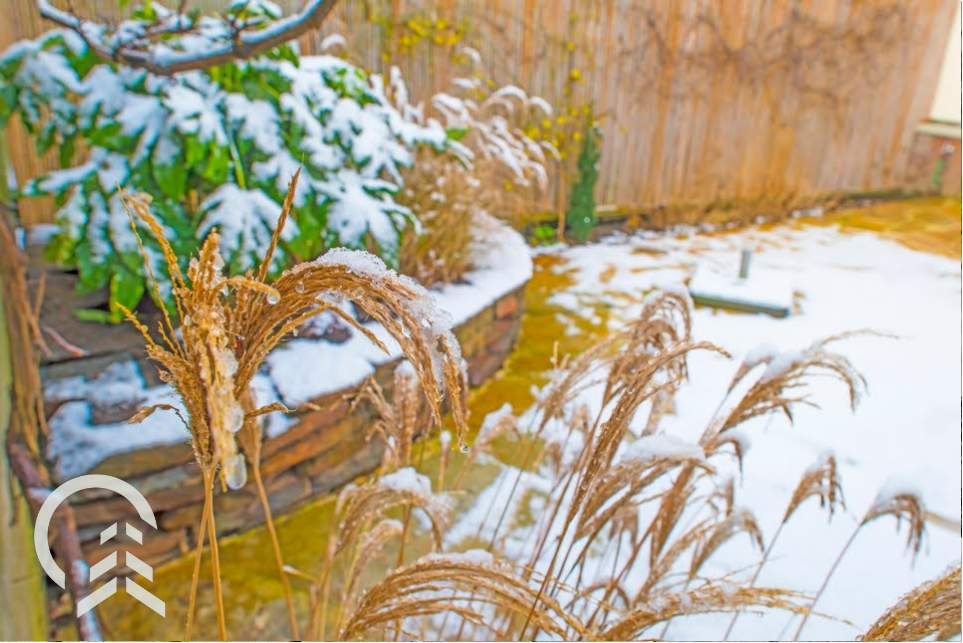Winter doesn’t mean your garden has to look barren and lifeless. In fact, with the right selection of hardy plants, you can enjoy a vibrant, lush garden even in the coldest months. Whether you’re looking to add some evergreen charm, bright berries, or frost-resistant blooms, we’ve got you covered. In this guide, we’ll introduce you to 15 outdoor plants that can withstand the harsh Chicagoland winters, keeping your garden looking beautiful and full of life until spring returns.
Calamagrostis x acutiflora ‘Karl Foerster’ (Feather Reed Grass)
Calamagrostis x acutiflora ‘Karl Foerster’, commonly known as Feather Reed Grass, is a standout choice for adding year-round interest to your garden. This tall, clump-forming grass features slender, upright stems topped with feathery plumes that turn a golden hue as the season progresses. It’s incredibly resilient, easily withstanding the frigid temperatures of Chicagoland winters.
Gardening Tips:
- Planting: Choose a sunny spot with well-drained soil. While it’s adaptable to a variety of soil types, it prefers slightly moist conditions.
- Watering: Once established, it’s relatively drought-tolerant. Water regularly during the first growing season to establish a deep root system.
- Maintenance: Cut back the old foliage to the ground in late winter or early spring before new growth appears. This helps maintain its tidy appearance and encourages vigorous growth.
- Companion Plants: Pair it with other cold-hardy perennials like Coneflowers or Black Eyed Susans for a stunning winter display.
Feather Reed Grass is a low-maintenance, high-impact addition to any garden, offering year-round beauty and resilience.
Festuca ‘Elijah Blue’ (Blue Fescue)
Festuca ‘Elijah Blue’, or Blue Fescue, is a delightful addition to any garden, bringing a touch of color and texture with its cool, green-blue foliage. This compact, mounding ornamental grass is perfect for borders, rock gardens, and container plantings. Known for its fine, needle-like leaves and tidy, rounded shape, Blue Fescue offers visual interest throughout the year, especially during the winter months.
Gardening Tips:
- Planting: Blue Fescue prefers a sunny location with well-drained soil. It’s particularly suited to sandy or rocky soils, making it ideal for rock gardens.
- Watering: While drought-tolerant once established, regular watering during the first growing season helps it develop a strong root system. Avoid overwatering, as it prefers drier conditions.
- Maintenance: Trim back old foliage in early spring to encourage new growth and maintain its neat appearance. Dividing the plants every few years helps rejuvenate them and prevents overcrowding.
- Companion Plants: Pair Blue Fescue with other drought-tolerant perennials like Stonecrop or Lavender for a harmonious and low-maintenance garden design.
Festuca ‘Elijah Blue’ is a charming and hardy grass that brings year-round beauty to your garden. It’s cold tolerance and low maintenance needs make it a perfect choice for winter interest.
Stachys ‘Hummelo’ (Betony)
Stachys ‘Hummelo’, commonly known as Betony, is a striking perennial that adds vibrant color and texture to any garden. It features dense spikes of rosy-purple flowers that rise above rosettes of rich, green foliage. This hardy plant not only blooms beautifully in the summer but also provides attractive foliage throughout the colder months.
Gardening Tips:
- Planting: Choose a location with full sun to partial shade and well-drained soil. Betony is adaptable to a range of soil types but prefers moderately fertile, moist soil.
- Watering: Water regularly, especially during dry spells, to keep the soil consistently moist. Once established, it can tolerate short periods of drought.
- Maintenance: Deadhead spent flowers to encourage prolonged blooming and trim back the foliage in late winter or early spring to make way for new growth. Dividing the plant every few years helps maintain its vigor and prevents overcrowding.
- Companion Plants: Betony pairs well with other perennials like Coneflowers, Sage, and ornamental grasses, creating a diverse and colorful garden display.
Stachys ‘Hummelo’ is a robust and versatile plant that offers year-round interest. It’s cold tolerance and attractive foliage make it an excellent choice for adding both beauty and resilience to your winter garden.
If it does happen to freeze back, don’t worry. Simply treat it like a typical perennial and cut it back to the ground in early spring to encourage fresh growth.
Rugosa Rose (Rosa rugosa)
Rugosa Rose, or Rosa rugosa, is a robust and charming addition to any garden, known for its fragrant, vibrant blooms and hardy nature. This resilient rose produces stunning, deep pink, lavender, yellow, and white flowers throughout the summer and into fall, followed by bright red hips that persist into winter, providing both visual interest and food for wildlife.
Gardening Tips:
- Planting: Choose a sunny location with well-drained soil. Rugosa roses are adaptable to various soil types, including sandy and poor soils, making them ideal for a wide range of garden settings.
- Watering: Water regularly during the first growing season to establish a strong root system. Once established, they are quite drought-tolerant but will benefit from occasional deep watering during prolonged dry periods.
- Maintenance: Prune in late winter or early spring to remove any dead or damaged wood and to shape the plant. Deadheading spent flowers will encourage continuous blooming, but leave some hips on the plant for winter interest and wildlife.
- Companion Plants: Pair Rugosa Rose with other cold-hardy perennials like Russian Sage or ornamental grasses for a stunning, low-maintenance garden display.
Rugosa Rose is a resilient and beautiful plant that brings year-round interest to your garden. The bright red hips are not only decorative but also attract birds, adding an extra layer of life and movement to your winter landscape. Its ability to withstand cold temperatures, along with its attractive flowers and hips, makes it a perfect choice for adding color and texture to your winter garden.
Callicarpa dichotoma ‘Issai’ (Beautyberry)
Callicarpa dichotoma ‘Issai’, commonly known as Beautyberry, is a stunning shrub that brings a splash of color to your garden, especially in the fall and winter months. This plant is famous for its clusters of vivid purple berries that appear in late summer and persist into early to mid-winter, creating a striking contrast against its green foliage.
Gardening Tips:
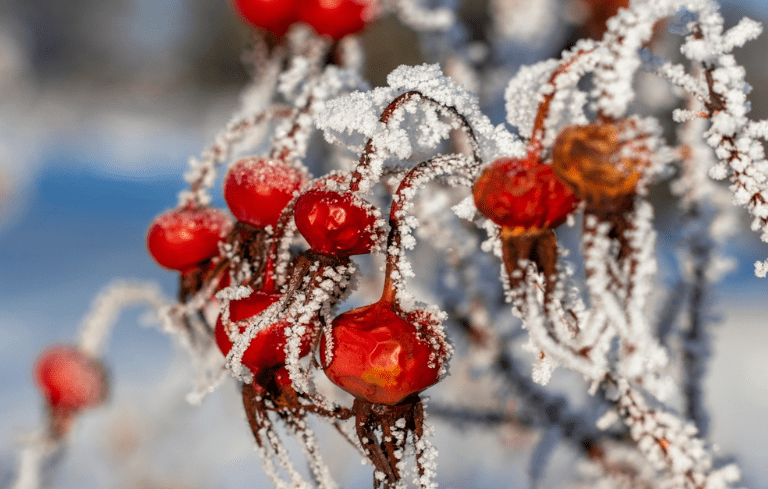
- Planting: Choose a spot with full sun to partial shade and well-drained soil. Beautyberry adapts well to different soil types but thrives in rich, loamy soil.
- Watering: Water regularly during the first growing season to establish a deep, extensive root system. Once established, Beautyberry is moderately drought-tolerant but benefits from consistent moisture.
- Maintenance: Prune in late winter or early spring to maintain its shape and encourage healthy new growth. Beautyberry responds well to hard pruning, which can help control its size and improve berry production.
- Companion Plants: Pair Beautyberry with other winter-interest plants like Winterberry Holly or ornamental grasses to create a visually captivating garden display.
Callicarpa dichotoma ‘Issai’ is an excellent choice for adding color and interest to your winter garden.
Corylus avellana ‘Harry Lauder’s Walking Stick’ (Contorted Filbert)
Corylus avellana ‘Harry Lauder’s Walking Stick’, also known as Contorted Filbert, is a unique and eye-catching shrub that adds year-round interest to your garden. Its twisted, gnarled branches provide a dramatic architectural element, particularly in winter when the bare branches stand out against the landscape.
Gardening Tips:
- Planting: Select a location with full sun to partial shade and well-drained soil. Contorted Filbert is adaptable to various soil types but prefers fertile, moist soil.
- Watering: Water regularly during the first growing season to establish a strong root system. Once established, it is relatively drought-tolerant but will benefit from occasional deep watering during prolonged dry spells.
- Maintenance: Prune in late winter or early spring to remove any dead or diseased wood and to enhance the shape of the plant. Its twisted branches are naturally artistic, so minimal pruning is needed to maintain its form.
- Companion Plants: Pair Contorted Filbert with other winter-interest plants like Red Twig Dogwood or Lenten Rose to create a visually captivating garden display.
This plant is particularly striking in October, as its contorted, almost spooky branches lend a whimsical and eerie vibe to your garden—perfect for Halloween. The gnarled shapes of its branches look like something out of a fairy tale, adding a touch of mystery and magic to your autumn landscape.
Betula nigra (River Birch)
Betula nigra, commonly known as River Birch, is a versatile and attractive tree that enhances any landscape with its striking bark and graceful form. Known for its peeling, salmon-pink to reddish-brown bark, which becomes papery and curls back to reveal a lighter inner bark, the River Birch is a beautiful addition to gardens throughout the year.
Gardening Tips:
- Planting: Select a site with full sun to partial shade and moist, well-drained soil. River Birch is particularly tolerant of wet soils, making it ideal for areas that are periodically flooded or have poor drainage.
- Watering: Water regularly, especially during dry spells, to keep the soil consistently moist. This tree is more drought-tolerant once established, but consistent watering helps it thrive.
- Maintenance: Prune in late winter to early spring to remove any dead, damaged, or crossing branches. Regular pruning helps maintain its shape and health.
- Companion Plants: Pair River Birch with moisture-loving plants like ferns, hostas, and astilbes to create a lush and harmonious garden. Underplanting with ground covers like wild ginger or vinca can also help maintain soil moisture.
Betula nigra is a dynamic and hardy tree that brings beauty and function to your landscape. Tolerant of wet soils, the River Birch is ideal for adding character and resilience to your garden year-round, even in areas with poor drainage.
Acer griseum (Paperbark Maple)
Acer griseum, commonly known as the Paperbark Maple, is a standout tree that brings year-round beauty to any garden. Known for its cinnamon-colored, exfoliating bark and trifoliate leaves, this tree offers stunning visual interest, especially in the fall and winter months.
Gardening Tips:
- Planting: Choose a location with full sun to partial shade and well-drained soil. Paperbark Maple is adaptable but performs best in slightly acidic, fertile soil.
- Watering: Water regularly during the first few years to establish a strong root system. Once established, it is moderately drought-tolerant but benefits from consistent moisture, especially during dry periods.
- Maintenance: Minimal pruning is required, but remove any dead or crossing branches in late winter to early spring. Its naturally beautiful form often needs little intervention to maintain.
- Companion Plants: Pair Paperbark Maple with other winter-interest plants like Lenten Rose or evergreen shrubs to enhance its beauty. Underplant with shade-tolerant perennials like hostas or ferns for a lush, layered look.
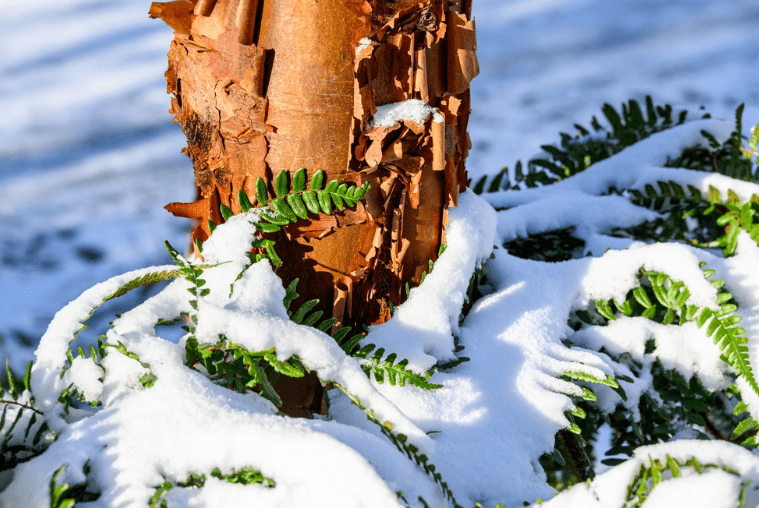
The Paperbark Maple grows slowly, but its year-round appeal makes it well worth the wait. Its unique bark, stunning fall foliage, and low-maintenance nature make it a perfect addition for those looking to add beauty and structure to their outdoor space year-round.
Cornus sericea ‘Baileyi’ (Red Twig Dogwood)
Cornus sericea ‘Baileyi’, commonly known as Red Twig Dogwood, is a striking shrub that adds vibrant color to your garden, especially during the winter months. Its brilliant red stems stand out against the winter landscape, providing a splash of color when most plants are dormant.
Gardening Tips:
- Planting: Choose a location with full sun to partial shade and well-drained, moist soil. This adaptable shrub can tolerate a variety of soil types.
- Watering: Water regularly, especially during the first growing season, to establish a strong root system. Once established, it can tolerate occasional dry spells but thrives best with consistent moisture.
- Maintenance: Prune in late winter or early spring to remove any dead or damaged stems and to promote new growth. Cutting back a third of the oldest stems each year will encourage the development of vibrant new stems.
- Companion Plants: Pair Red Twig Dogwood with other winter-interest plants like Winterberry Holly (Ilex verticillata) or ornamental grasses for a dynamic and colorful winter garden.
Red Twig Dogwood is particularly striking in winter when its bright red stems create a dramatic contrast against the snow. This vibrant display makes it a standout plant for adding winter interest and visual appeal to your landscape.
Thuja occidentalis ‘Smaragd’ (Emerald Green Arborvitae)
Thuja occidentalis ‘Smaragd’, commonly known as Emerald Green Arborvitae, is a popular evergreen shrub valued for its vibrant green foliage and narrow, pyramidal shape. This low-maintenance plant provides year-round interest and is perfect for creating privacy screens, hedges, or as a standout specimen in your garden.
Gardening Tips:
- Planting: Choose a location with full sun to partial shade and well-drained soil. While it prefers slightly acidic to neutral soils, it is adaptable to various soil types as long as they are not waterlogged.
- Watering: Water regularly during the first growing season to establish a deep root system. Once established, it is moderately drought-tolerant but benefits from regular watering during prolonged dry periods.
- Maintenance: Minimal pruning is needed to maintain its shape. Trim lightly in late spring or early summer to remove any dead or damaged branches and to encourage dense growth.
- Companion Plants: Pair Emerald Green Arborvitae with other evergreens like Boxwood (Buxus) or contrasting plants like Panicle Hydrangeas for a striking landscape design.
Thuja occidentalis ‘Smaragd’ is a versatile and reliable choice for any landscape. When planted in a row, its hardy nature and vibrant foliage make for an excellent privacy screen, providing year-round coverage and a lush, green barrier.
Yucca ‘Color Guard’
Yucca ‘Color Guard’ is a striking perennial that adds bold texture and color to your garden. Known for its sword-like leaves with vibrant yellow centers and green edges, this plant provides year-round interest and a touch of the exotic to your landscape.
Gardening Tips:
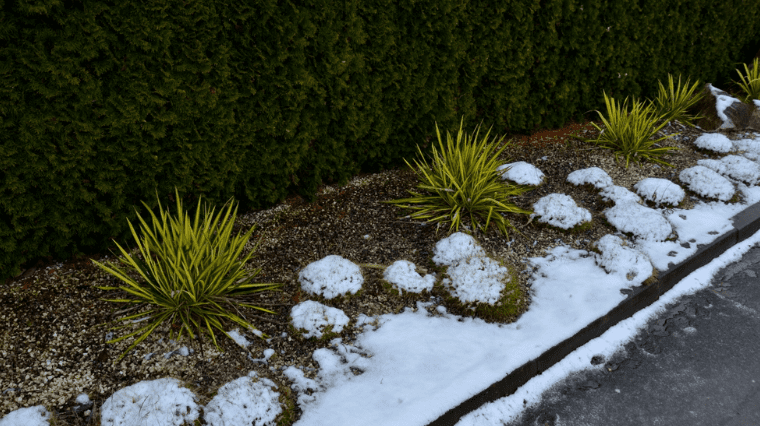
- Planting: Choose a sunny location with well-drained soil. Yucca ‘Color Guard’ is highly adaptable and thrives in poor, sandy soils, making it ideal for rock gardens and xeriscaping.
- Watering: Water sparingly, as this plant is drought-tolerant once established. Overwatering can lead to root rot, so it’s best to let the soil dry out between waterings.
- Maintenance: Minimal maintenance is required. Remove dead or damaged leaves as needed, and trim the flower stalks after blooming to keep the plant tidy.
- Companion Plants: Pair ‘Color Guard’ with other drought-tolerant plants like Stonecrop or ornamental grasses for a visually dynamic and low-maintenance garden.
Yucca ‘Color Guard’ stands out in the garden with its dramatic foliage that remains vibrant even in winter. Its variegated leaves can add a pop of color to snowy landscapes, and the tall flower spikes that appear in summer add vertical interest.
Echinacea (Coneflower)
Echinacea, commonly known as Coneflower, is a beloved perennial that brings vibrant color and ecological benefits to any garden. Known for its daisy-like flowers with prominent, cone-shaped centers, this plant is a favorite among gardeners and pollinators alike.
Gardening Tips:
- Planting: Select a sunny location with well-drained soil. Echinacea is adaptable to a variety of soil types but prefers moderately fertile conditions. Plant in clusters for the best visual impact.
- Watering: Water regularly during the first growing season to establish a strong root system. Once established, Coneflowers are drought-tolerant but benefit from occasional watering during prolonged dry periods.
- Maintenance: Deadhead spent flowers to encourage continuous blooming throughout the summer. In late fall, leave some seed heads on the plants to provide food for birds and winter interest. Cut back old growth in early spring to make way for new shoots.
- Companion Plants: Pair Coneflowers with other native perennials like Black-eyed Susan, Bee Balm, or ornamental grasses to create a diverse and colorful garden.
Echinacea is not only beautiful but also supports local wildlife. Its nectar-rich flowers attract bees, butterflies, and other pollinators, while its seeds provide food for birds in the fall and winter.
Rudbeckia (Black-Eyed Susan)
Rudbeckia, commonly known as Black-Eyed Susan, is a cheerful and resilient perennial that brightens up any garden with its sunny yellow flowers and dark, cone-shaped centers. This hardy plant is a staple in many gardens due to its vibrant blooms and easy care.
Gardening Tips:
- Planting: Choose a sunny location with well-drained soil. Rudbeckia is adaptable to a variety of soil types but prefers moderately fertile, moist soil. Plant in groups for the best visual impact.
- Watering: Water regularly during the first growing season to establish a strong root system. Once established, Black-Eyed Susans are drought-tolerant but benefit from occasional watering during extended dry periods.
- Maintenance: Deadhead spent flowers to encourage continuous blooming throughout the summer. In late fall, leave some seed heads on the plants to provide food for birds and add winter interest. Cut back old growth in early spring to make way for new shoots.
- Companion Plants: Pair Black-Eyed Susan with other hardy perennials like Coneflower, Russian Sage, or ornamental grasses to create a diverse and colorful garden.
Rudbeckia is a versatile and low-maintenance plant that adds vibrant color to your garden. Its cheerful blooms and hardiness make it an excellent choice for gardeners looking to create a lively and sustainable outdoor space.
Symphoricarpos ‘Candy’ (Coralberry)
Symphoricarpos ‘Candy’, commonly known as Coralberry, is a charming deciduous shrub that adds a splash of color to your garden with its clusters of vibrant pink berries. This low-maintenance plant is perfect for adding interest to your garden throughout the fall and winter months.
Gardening Tips:
- Planting: Choose a location with full sun to partial shade and well-drained soil. Coralberry is adaptable to various soil types, including poor soils, making it a versatile choice for different garden settings.
- Watering: Water regularly during the first growing season to establish a strong root system. Once established, it is quite drought-tolerant but will benefit from occasional watering during prolonged dry periods.
- Maintenance: Prune in late winter or early spring to remove any dead or damaged wood and to shape the plant. Light pruning encourages denser growth and more prolific berry production.
- Companion Plants: Pair Coralberry with other winter-interest plants like Winterberry Holly or ornamental grasses for a visually captivating garden display.
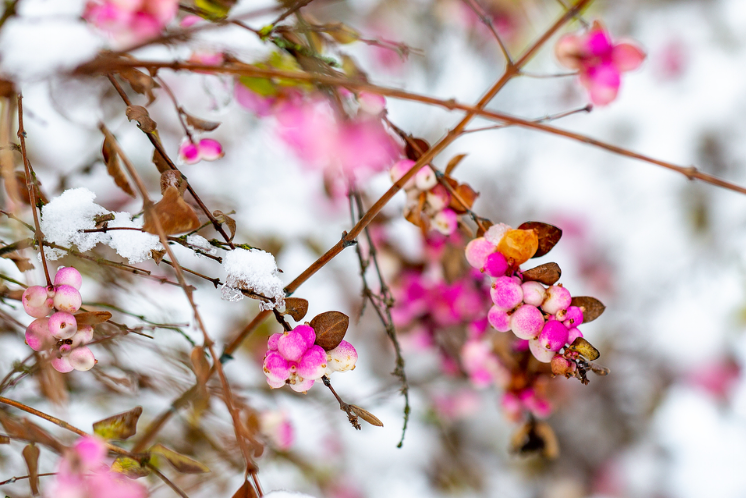
Symphoricarpos ‘Candy’ is a delightful and hardy shrub that brings year-round interest to your garden. Its vibrant berries, cold tolerance, and low-maintenance nature make it a perfect choice for adding color and ecological value to your winter landscape.
Sedum kamtschaticum (Stonecrop)
Sedum kamtschaticum, commonly known as Stonecrop, is a hardy and low-maintenance perennial that adds vibrant color and texture to your garden. This tough plant is known for its succulent, green leaves and bright yellow, star-shaped flowers that turn reddish-bronze in cold weather.
Gardening Tips:
- Planting: Choose a sunny location with well-drained soil. Sedum kamtschaticum is very adaptable and thrives in poor, sandy, or rocky soils, making it ideal for rock gardens, borders, and ground covers.
- Watering: Water sparingly, as Stonecrop is drought-tolerant once established. Overwatering can lead to root rot, so it’s best to let the soil dry out between waterings.
- Maintenance: Minimal maintenance is required. Trim back the spent flower stems after blooming to maintain a tidy appearance. Divide the plants every few years to prevent overcrowding and promote vigorous growth.
- Companion Plants: Pair Stonecrop with other drought-tolerant plants like Coneflowers, Lavender, or ornamental grasses for a visually dynamic and low-maintenance garden.
Sedum kamtschaticum is a versatile and resilient plant that brings year-round beauty to your garden. Its hardy nature, vibrant flowers, and low-maintenance requirements make it an excellent choice for gardeners looking to add color and texture to their outdoor spaces, even in the most challenging conditions.
Conclusion
Winter doesn’t have to be a dull time for your garden. By incorporating these 15 outdoor plants, you can ensure your garden remains colorful and interesting all year round. Whether you’re adding vertical interest with grasses, vibrant color with berries, or architectural beauty with unique branches, these plants will keep your garden looking its best through the coldest months.
At Platt Hill Nursery, we’re passionate about helping you create a garden that thrives year-round. Whether you’re looking to add evergreen charm, bright berries, or frost-resistant blooms, our selection of winter-hardy plants will ensure your garden remains a beautiful and lively space, no matter the season. Visit us to explore our full range of plants and get expert advice on creating a stunning winter garden.

